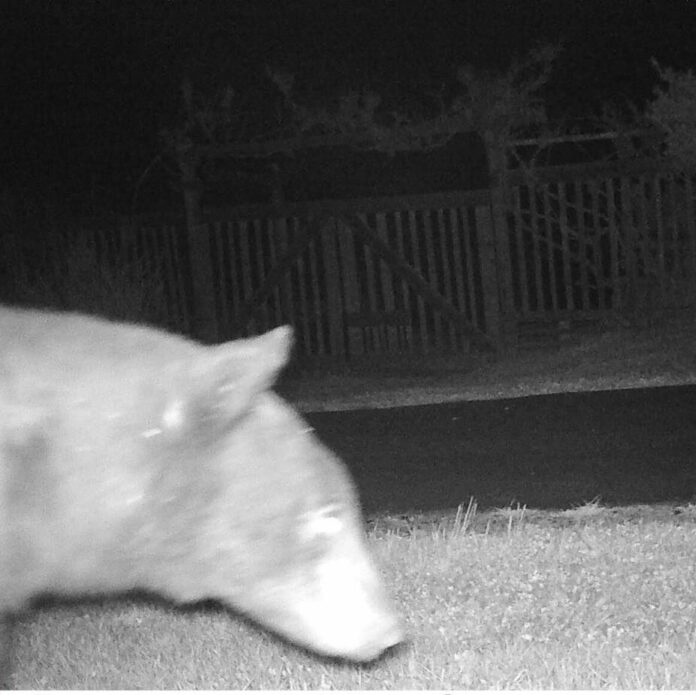Bear spotted on Sebastopol residential trail camera
A residential trail camera caught sight of a bear near Hessel Road, according to an early morning post crammed with puns on Monday, May 3 by the Sebastopol Police Services Facebook page.
The Facebook post did not say when the bear was spotted, but that the sighting took place around Pleasant Hill Road, Lynch Road and Robinson Road.
Anyone who encounters the animal should “show some forbearance and give him a wide berth,” the post said.
The Sebastopol Police Services Facebook posted directions Monday night, May 3 from the California Department of Fish and Wildlife on what folks living where the bear was seen can do to prevent the bear from returning to populated areas and “stay wild,” instead.
Locals were asked to bring any outdoor pet food and trash inside, empty bird feeders and either bring barbecue grills inside or keep them clean. “Essentially, we want to remove any food source so that the bear will move on to a more natural menu,” the post said.
The police department’s Facebook post included this link from the Department of Fish and Wildlife for more information on keeping black bears away from one’s home or campsite, such as bringing pets indoors and livestock in a secure location at night.
“Are they moving into our territory? It may be more accurate to say we’ve moved into theirs,” said Hattie Brown, the natural resource manager at Sonoma County Regional Parks.
She said humans and bears have been coexisting in Sonoma County for a long time and based on the location, the animal spotted is probably a black bear.
“This time of year is probably a time of dispersal,” Brown said, prefacing that she is not an expert on bears and others will know more. “So, as young animals grow up and get kicked out of the nest, literal or figurative, they have to strike out and find territory on their own, so this time of year is potentially that time of year.”
There is also a hypothesis that black bears are to some extent filling a void left when grizzly bears were hunted and forced out of the area, Brown said. California grizzly bears were driven to extinction by 1924 after settlers came out for the gold rush and hunted them by the thousands, according to the California Museum website.
“So, we’re actually, maybe living in that sort of ecological transition where black bears are filling in that niche that grizzlies had historically filled and left vacant,” she said, though she referred to this as a “working theory.”
It can be difficult to tell whether wildfires and drought conditions are currently driving wild animals to more populated areas, or whether the fires are permanently displacing local bears, according to Brown.
“Certainly, they’re on the move in the case of a wildfire to escape the actual flames, and, we believe, generally successfully doing so,” she said. “And we typically do see evidence of animals returning to a post-fire landscape very, very quickly.”
Brown said an organization called the North Bay Bear Collaborative is tracking cases to better understand the bear populations in the area and where they’re located, “all with an eye to really facilitate … basically coexistence on the landscape and to try to really reduce and prevent any possible negative interactions with bears.”
Tahoe serves as a “cautionary tale” for Sonoma County of bears getting too comfortable with humans, digging into trash and sometimes homes, she said.
Local efforts seek to understand bear populations and how to share the land “so that Sonoma County doesn’t become a dangerous place for bears or for people, but really for bears because the threat, for the most part, is that if bears get very habituated to people, they will become a nuisance and potentially then depredated.”
In other words, such a bear may be relocated or killed, Brown explained. California allows depredation permits for landowners to kill a black bear that causes serious damage to property or livestock or enters a home as a last resort when preventative actions fail, according to the Department of Fish and Wildlife.
When there’s a depredation permit, the bear dies around 40% of the time, per the department. But that’s the last of three categories for increasing damage and responses per state policy found on the fish and wildlife department’s website here.
Bears that just wander into a populated vicinity would be distracted, driven out or tranquilized and removed from the area, the department’s website said.
Residents would be told to take bear-proofing measures for bears in the second category that return to the area or grow used to people, knocking over garbage cans and causing other milder disruptions, according to the website. Like bears in the first category, the habituated bears may be expelled with measures like sound makers or sling-shot projectiles, the website said.
Police Chief Kevin Kilgore said the information had originally been posted on social media and that the Sebastopol Police Department pulled it from Nextdoor to alert the local community, also contacting the fish and wildlife department for their resources.
“One thing that we want to make sure is that we’re notifying our community to be aware of any type of wildlife that may be in the area that could pose any type of safety concerns to anyone,” he said in a May 4 interview.
Kilgore said he does not know for sure when the camera spotted the bear, but that the trail camera appeared to show the time as April 30, near 10 p.m..
56.3
F
Healdsburg
April 22, 2025









